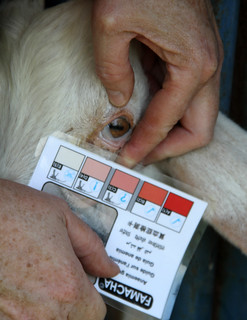Fourteen goats met the Gold standards for parasite resilience, never having a FAMACHA© score above 2 or requiring treatment with an anthelmintic. An additional 15 goats met the Bronze standards for parasite resilience, never having a FAMACHA© score above 3. Bronze goats could have been dewormed once. There were no Silver standards for parasite resilience.
FAMACHA© scores were used to quantify parasite resilience. They are an estimate of packed cell volume (PVC). Packed cell volume is a measure of anemia. It is the amount of red blood cells in whole blood. The barber pole worm is a blood-sucker, causing its victims to suffer blood and protein loss (thus anemia). "Bottle jaw" (edema), an accumulation of fluid under the jaw is another symptom of Haemonchosis, but it is seldom observed in the goats in the test.
The need for anthelmintic treatment is another indication of parasite resilience. Goats with FAMACHA© scores of 1 and 2 were not dewormed, whereas goats with FAMACHA© scores of 4 and 5 were dewormed. Goats with FAMACHA© scores of 3 were dewormed, if other factors justified treatment. Nineteen (38%) of the bucks in the test never required an anthelmintic treatment.
The most parasite resilient buck in the 2012 test was #24, a Kiko buck consigned by Randy & Jodie Majancsik (KY). This buck had an average FAMACHA© score of 1.3. In fact, four of the five most parasite resilient bucks were consigned by Majancsik. Hanna Zitta/John Smith (VA) had three of the ten most resilient bucks in the test. Sam Burke (DE) had the 4th most resilient buck.
For the purpose of consistency, FAMACHA© scores were always determined by Susan Schoenian. Thus, any scoring "bias" was equal for all goats and each scoring period.
Download final FAMACHA© report
Download final FAMACHA© rankings
It is important that potential breeding bucks be both resistance and resilient to internal parasites.
FAMACHA© scores were used to quantify parasite resilience. They are an estimate of packed cell volume (PVC). Packed cell volume is a measure of anemia. It is the amount of red blood cells in whole blood. The barber pole worm is a blood-sucker, causing its victims to suffer blood and protein loss (thus anemia). "Bottle jaw" (edema), an accumulation of fluid under the jaw is another symptom of Haemonchosis, but it is seldom observed in the goats in the test.
The need for anthelmintic treatment is another indication of parasite resilience. Goats with FAMACHA© scores of 1 and 2 were not dewormed, whereas goats with FAMACHA© scores of 4 and 5 were dewormed. Goats with FAMACHA© scores of 3 were dewormed, if other factors justified treatment. Nineteen (38%) of the bucks in the test never required an anthelmintic treatment.
The most parasite resilient buck in the 2012 test was #24, a Kiko buck consigned by Randy & Jodie Majancsik (KY). This buck had an average FAMACHA© score of 1.3. In fact, four of the five most parasite resilient bucks were consigned by Majancsik. Hanna Zitta/John Smith (VA) had three of the ten most resilient bucks in the test. Sam Burke (DE) had the 4th most resilient buck.
For the purpose of consistency, FAMACHA© scores were always determined by Susan Schoenian. Thus, any scoring "bias" was equal for all goats and each scoring period.
Download final FAMACHA© report
Download final FAMACHA© rankings
It is important that potential breeding bucks be both resistance and resilient to internal parasites.













